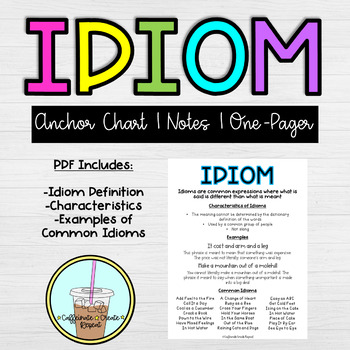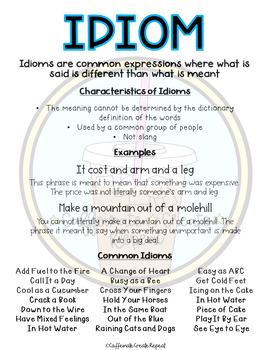Idiom | Anchor Chart | Notes | One Pager | Distance Learning | Google Slides
Caffeinate Create Repeat
312 Followers
Grade Levels
6th - 9th, Homeschool
Subjects
Resource Type
Standards
CCSSRL.5.1
CCSSRL.5.4
CCSSRL.6.4
CCSSRL.7.1
CCSSRL.7.4
Formats Included
- Zip
- Google Apps™
Caffeinate Create Repeat
312 Followers

Includes Google Apps™
The Teacher-Author indicated this resource includes assets from Google Workspace (e.g. docs, slides, etc.).
Also included in
- In this READING ANCHOR CHART GROWING BUNDLE, you will find mini-anchor charts or notes for notebooks, folders, and student binders. Each READING ANCHOR CHART concept includes a definition, examples, and various other details students would need for that concept. You can use theses products to teachPrice $19.00Original Price $24.50Save $5.50
Description
Use this Idiom Anchor Chart | Notes | One Pager to teach Idioms or to review Idioms with your students! This Idiom Anchor Chart and Notes Page is perfect for students' notebooks, folders, or binders. Idioms can be difficult to master! Give your students this aid!
Includes the definition of idiom, the characteristics of idioms, and common examples of of idioms!
Included in this Resource:
- PPT version of Idiom Anchor Chart
- PDF version of Idiom Anchor Chart
- Google Slides version of Anchor Chart
This product can be used as a notes page, anchor chart, or wall decor in the classroom! Students will use these notes to reference the rules and read examples on the concept!
Total Pages
Answer Key
N/A
Teaching Duration
N/A
Report this resource to TPT
Reported resources will be reviewed by our team. Report this resource to let us know if this resource violates TPT’s content guidelines.
Standards
to see state-specific standards (only available in the US).
CCSSRL.5.1
Quote accurately from a text when explaining what the text says explicitly and when drawing inferences from the text.
CCSSRL.5.4
Determine the meaning of words and phrases as they are used in a text, including figurative language such as metaphors and similes.
CCSSRL.6.4
Determine the meaning of words and phrases as they are used in a text, including figurative and connotative meanings; analyze the impact of a specific word choice on meaning and tone.
CCSSRL.7.1
Cite several pieces of textual evidence to support analysis of what the text says explicitly as well as inferences drawn from the text.
CCSSRL.7.4
Determine the meaning of words and phrases as they are used in a text, including figurative and connotative meanings; analyze the impact of rhymes and other repetitions of sounds (e.g., alliteration) on a specific verse or stanza of a poem or section of a story or drama.




